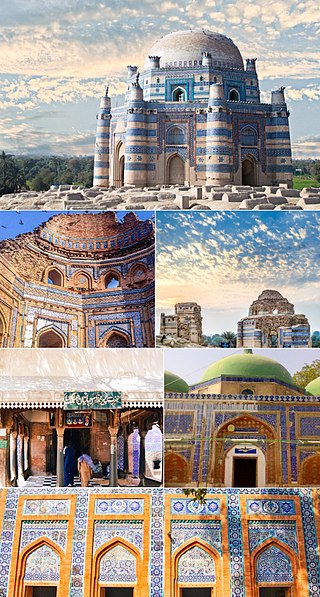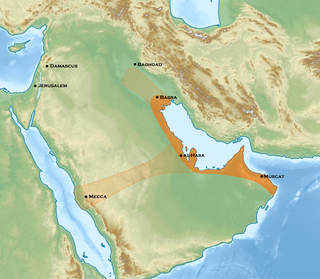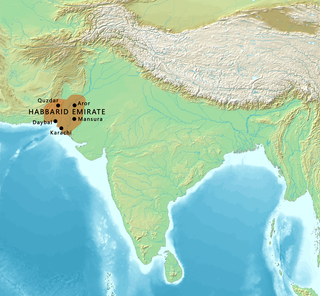Related Research Articles

Multan is a city in Punjab, Pakistan, located on the bank of river Chenab. It is one of the five largest urban centres of Pakistan in 2025 and is the administrative centre of Multan Division. It is a major cultural, religious and economic centre of Punjab region. Located in central Pakistan, with a district population of 5.3 million, it is the main hub of Southern Punjab.

The Ghaznavid dynasty was a Persianate Muslim dynasty of Turkic mamluk origin. It ruled the Ghaznavid Empire or the Empire of Ghazni from 977 to 1186, which at its at its greatest extent, extended from the Oxus to the Indus Valley. The dynasty was founded by Sabuktigin upon his succession to the rule of Ghazna after the death of his father-in-law, Alp Tigin, who was an ex-general of the Samanid Empire from Balkh.

Abu al-Qasim Mahmud ibn Sabuktigin, usually known as Mahmud of Ghazni or Mahmud Ghaznavi, was Sultan of the Ghaznavid Empire, ruling from 998 to 1030. During his reign and in medieval sources, he is usually known by his honorific title Yamin al-Dawla. At the time of his death, his kingdom had been transformed into an extensive military empire, which extended from northwestern Iran proper to the Punjab in the Indian subcontinent, Khwarazm in Transoxiana, and Makran.

Uch, frequently referred to as Uch Sharīf, is a historic city in the Pakistan's Punjab province. Uch may have been founded as Alexandria on the Indus, a town founded by Alexander the Great during his invasion of the Indus Valley. Uch was an early stronghold of the Delhi Sultanate during the Muslim conquest of the subcontinent. It is also known as the home for the Naqvi/Bukhari's after the migration from Bukhara. Uch was a regional metropolitan centre between the 12th and 17th centuries, and became refuge for Muslim religious scholars fleeing persecution from other lands. Though Uch is now a relatively small city, it is renowned for its intact historic urban fabric, and for its collection of shrines dedicated to Muslim mystics (Sufis) from 12th to 15th centuries that are embellished with extensive tile work, and were built in the distinct architectural style of southern Punjab.

The Qarmatians were a militant Isma'ili Shia movement centred in Al-Ahsa in Eastern Arabia, where they established a religious—and, as some scholars have claimed, proto-socialist or utopian socialist—state in 899 CE. Its members were part of a movement that adhered to a syncretic branch of Sevener Ismaili Shia Islam, and were ruled by a dynasty founded by Abu Sa'id al-Jannabi, a Persian from Jannaba in coastal Fars. They rejected the claim of Fatimid Caliph Abdallah al-Mahdi Billah to imamate and clung to their belief in the coming of the Mahdi, and they revolted against the Fatimid and Abbasid Caliphates.

Thatta is a city in the Pakistani province of Sindh. Thatta was the medieval capital of Sindh, and served as the seat of power for three successive dynasties. Its construction was ordered by Jam Nizamuddin II in 1495. Thatta's historic significance has yielded several monuments in and around the city. Thatta's Makli Necropolis, a UNESCO World Heritage Site, is site of one of the world's largest cemeteries and has numerous monumental tombs built between the 14th and 18th centuries designed in a syncretic funerary style characteristic of lower Sindh. The city's 17th century Shah Jahan Mosque is richly embellished with decorative tiles, and is considered to have the most elaborate display of tile work in the South Asia.

Wilferd Ferdinand Madelung FBA was a German author and scholar of Islamic history widely recognised for his contributions to the fields of Islamic and Iranian studies. He was appreciated in Iran for his "knowledgeable and fair" treatment of the Shia perspective. In the obituary of the Institute of Ismaili Studies (London) where Madelung worked his last years, it reads: "With particular reference to religious schools and movements in early Islam, his studies, based on a vast array of primary sources, have enriched the discipline’s understanding of almost every major Muslim movement and community – not only early Imami Shi‘ism and the later developments of Twelver, Ismaili and Zaydi Islam but also the lesser known aspects of Sunni, Khariji and the Mu‘tazili schools of theology and philosophy."
Tayyibi Isma'ilism is the only surviving sect of the Musta'li branch of Isma'ilism, the other being the extinct Hafizi branch. Followers of Tayyibi Isma'ilism are found in various Bohra communities: Dawoodi, Sulaymani, and Alavi.
Soomro, Soomra,Sumrah or Sumra is a tribe having a local origin in Sindh. They are found in Sindh, parts of Punjab especially bordering Sindh, Balochistan province, and the Kutch district of the Indian state of Gujarat and also Rajasthan. The Soomras ruled throughout the Sindh and Multan regions.
Samma is a tribe that has origins in Sindh. The Samma are spread across Pakistan and North-West India. The Sandhai Muslims are Samma who converted to Islam. Offshoots of the main branch of Samma include the Jadejas and Chudasamas of India.
Multan in Punjab province of Pakistan is one of the oldest cities of South Asia, though its exact age has yet to be determined. Multan is known for its rich ancient heritage and historic landmarks. Multan was the primary cultural centre or capital of Punjab region mostly in late ancient and medieval era. Multan region was centre of many civilizations in its 5 millennia old history, and witnessed warfare across millennia because of its location on a major invasion route between South and Central Asia.

The Mihrabanid dynasty was a Persian Muslim dynasty that ruled Sistan from 1236 until the mid-16th century. It was the third indigenous Muslim dynasty of Sistan, having been preceded by the Saffarid and Nasrid dynasties.

The Habbari were an Arab dynasty that ruled much of Greater Sindh, as a semi-independent emirate from 854 to 1024. Beginning with the rule of 'Umar bin Abdul Aziz al-Habbari in 854 CE, the region became semi-independent from the Abbasid Caliphate in 861, while continuing to nominally pledge allegiance to the Abbasid Caliph in Baghdad. The Habbari ascension marked the end of a period of direct rule of Sindh by the Umayyad and Abbasid Caliphates, which had begun in 711 CE.

The Soomra dynasty was a late medieval dynasty of Sindh ruled by the Soomro tribe of Sindh, and at times adjacent regions, located in what is now Pakistan.
Farhad Daftary is a Belgian-born Iranian-British Islamic scholar who is co-director and head of the Department of Academic Research and Publications at the Institute of Ismaili Studies in London. He is related to the Aga Khan IV.
The Sun Temple of Multan was a temple dedicated to Surya, the Hindu Sun God, in the city of Multan in modern Pakistan. The location of the temple remains unknown; it is distinct from the Prahladpuri Temple.
The Lodi dynasty was the last dynasty to rule over Emirate of Multan, from their capital city of Multan in the 10th century.

The Emirate of Multan was a medieval kingdom in Punjab region in the northwest Indian subcontinent that was centred around city of Multan. It initially extended towards parts of Kashmir, and included parts of present-day Punjab. It was initially ruled by the tribe of Banu Munabbih. In 959 CE, Ismailis under the Banu Lawi gained control of the Emirate and in 1010, it was conquered by the Ghaznavid Empire.

The Ghaznavid campaigns in India refer to a series of military expeditions lasting 54 years (973–1027) launched by the Ghaznavid Empire, a prominent empire of the 10th and 11th centuries. They went into the Indian subcontinent, led primarily by Sultan Mahmud of Ghazni, leaving a profound impact on the region's history and culture.
The Ghaznavid conquest of Multan marked a significant turning point in the history of the region, leading to the decline of the Ismaili Emirate of Multan and the integration of the area into the Ghaznavid Empire. This period, spanning from 1005 to 1010 CE, was characterized by military campaigns, political intrigue, and the suppression of Ismaili influence in the region.
References
- ↑ Jonah Blank. Mullahs on the mainframe: Islam and modernity among the Daudi Bohras. University of Chicago Press, 2001, Page 37
- ↑ Manzoor Ahmad Hanifi. A short history of Muslim rule in Indo-Pakistan. Ideal Library, 1964 page 21
- ↑ Farhad Daftary. Ismailis in Medieval Muslim Societies. Institute of Ismaili Studies, I B Taurius and Company. Page 68
- ↑ Samina Rahman. Pre Mughal India. Page 61
- ↑ Mahar Abdul Haq Sumra. Historical study of Sumra dynasty of Sindh and Punjab from 11th through mid 14th century.Beacon Books
- ↑ Ismailis in Medieval Muslim Societies, By Farhad Daftary, Institute of Ismaili Studies, I B Taurus and Company. Page 68.